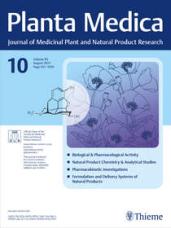Subscribe to RSS
DOI: 10.1055/s-0030-1249876
© Georg Thieme Verlag KG Stuttgart · New York
Neoandrographolide from Andrographis paniculata as a Potential Natural Chemosensitizer
Publication History
received January 5, 2010 revised February 17, 2010
accepted March 31, 2010
Publication Date:
05 May 2010 (online)

Abstract
Extracts of the traditional medicinal herb Andrographis paniculata and its main constituents are described in the literature as showing anticancer activity. The aim of this study was to isolate the main constituents of a commercially available phytotherapeutic preparation of A. paniculata and to determine their chemosensitizing potential in a leukemia cell line. Chromatographic separation steps resulted in the isolation of the diterpenes andrographolide (1) and 14-deoxy-11,12-didehydroandrographolide (3) and the diterpene glucoside neoandrographolide (2). The combination of these constituents with suboptimal concentrations of etoposide revealed compound 2 as chemosensitizer in S-Jurkat and X chromosome-linked inhibitor of apoptosis protein (XIAP)-overexpressing Jurkat cells, a model for chemoresistance.
Key words
Andrographis paniculata - Acanthaceae - neoandrographolide - chemosensitizer - etoposide
-
Supporting Information for this article is available online at
- Supporting Information .
References
- 1 Tang W, Eisenbrand G.
Andrographis paniculata (Burm. f.) Nees. Tang W, Eisenbrand G Chinese drugs of plant origin. Berlin, Heidelberg; Springer-Verlag 1992: 97-103 - 2 Matsuda T, Kuroyanagi M, Sugiyama S, Umehara K, Ueno A, Nishi K. Cell differentiation-inducing diterpenes from Andrographis paniculata Nees. Chem Pharm Bull. 1994; 42 1216-1225
- 3 Kumar R A, Sridevi K, Kumar N V, Nanduri S, Rajagopal S. Anticancer and immunostimulatory compounds from Andrographis paniculata. J Ethnopharmacol. 2004; 92 291-295
- 4 Cheung H-Y, Cheung S-H, Li J, Cheung C-S, Lai W-P, Fong W-F, Leung F-M. Andrographolide isolated from Andrographis paniculata induces cell cycle arrest and mitochondrial-mediated apoptosis in human leukemic HL-60 cells. Planta Med. 2005; 71 1106-1111
- 5 Yang L, Wu D, Luo K, Wu S, Wu P. Andrographolide enhances 5-fluorouracil-induced apoptosis via caspase-8-dependent mitochondrial pathway involving p 53 participation in hepatocellular carcinoma (SMMC-7721) cells. Cancer Lett. 2009; 276 180-188
- 6 Zhou J, Lu G-D, Ong C-S, Ong C-N, Shen H-M. Andrographolide sensitizes cancer cells to TRAIL-induced apoptosis via p 53-mediated death receptor 4 up-regulation. Mol Cancer Ther. 2008; 7 2170-2180
- 7 Fujita T, Fujitani R, Takeda Y, Takaishi Y, Yamada T, Kido M, Miura I. On the diterpenoids of Andrographis paniculata: X-ray crystallographic analysis of andrographolide and structure determination of new minor diterpenoids. Chem Pharm Bull. 1984; 32 2117-2125
- 8 Tan M L, Kuroyanagi M, Sulaiman S F, Najimudin N, Tengku Muhammad T S. Cytotoxic activities of major diterpenoid constituents of Andrographis paniculata in a panel of human tumor cell lines. Pharm Biol. 2005; 43 501-508
- 9 Wilkinson J C, Cepero E, Boise L H, Duckett C S. Upstream regulatory role for XIAP in receptor-mediated apoptosis. Mol Cell Biol. 2004; 24 7003-7014
- 10 Mosmann T. Rapid colorimetric assay for cellular growth and survival: application to proliferation and cytotoxicity assays. J Immunol Methods. 1983; 65 55-63
- 11 Nicoletti I, Migliorati G, Pagliacci M C, Grignani F, Riccardi C. A rapid and simple method for measuring thymocyte apoptosis by propidium iodide staining and flow cytometry. J Immunol Methods. 1991; 139 271-279
- 12 Greco W R, Bravo G, Parsons J C. The search for synergy: a critical review from a response surface perspective. Pharmacol Rev. 1995; 47 331-385
Prof. Dr. Hermann Stuppner
Institute of Pharmacy/Pharmacognosy
Center for Molecular Biosciences Innsbruck
Leopold-Franzens University of Innsbruck
Innrain 52c, Josef-Moeller-Haus
6020 Innsbruck
Austria
Phone: + 43 51 25 07 53 00
Fax: + 43 51 25 07 29 39
Email: hermann.stuppner@uibk.ac.at
-
www.thieme-connect.de/ejournals/toc/plantamedica
